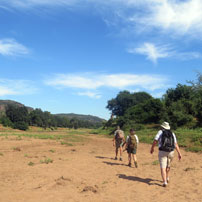 Always listen to your guide. One of the golden rules of a walking safari, or any safari for that matter, but particularly pertinent when it’s just you, your walking shoes and your guide out on foot in the middle of the bush. Our guide Calvin was reminding us of the golden rules of a walking safari on a crisp cold winter’s morning, as the sun was creeping up over the horizon in the Makuleke concession in the far northern Kruger, when all of a sudden a male hyaena appeared in the road, just metres away from us. Both parties were taken by surprise. We were immediately instructed to crouch and stay quiet and the hyaena felt the need to do the same, resulting in an intense staring contest for a good few minutes. I quickly realised that I had already broken another one of the golden rules of a walking safari, always stay behind your guide. It had all happened so quickly that I was the lucky person to be located at the front of the group and there was nothing between me and this curious hyaena. We could hear nothing except our own breath and the morning chorus of the local birdlife waking up around us. As quickly as the hyaena appeared, it disappeared into the bush.
Always listen to your guide. One of the golden rules of a walking safari, or any safari for that matter, but particularly pertinent when it’s just you, your walking shoes and your guide out on foot in the middle of the bush. Our guide Calvin was reminding us of the golden rules of a walking safari on a crisp cold winter’s morning, as the sun was creeping up over the horizon in the Makuleke concession in the far northern Kruger, when all of a sudden a male hyaena appeared in the road, just metres away from us. Both parties were taken by surprise. We were immediately instructed to crouch and stay quiet and the hyaena felt the need to do the same, resulting in an intense staring contest for a good few minutes. I quickly realised that I had already broken another one of the golden rules of a walking safari, always stay behind your guide. It had all happened so quickly that I was the lucky person to be located at the front of the group and there was nothing between me and this curious hyaena. We could hear nothing except our own breath and the morning chorus of the local birdlife waking up around us. As quickly as the hyaena appeared, it disappeared into the bush.
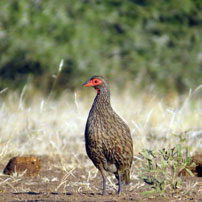
My Dad and I were spending a night on the Pafuri walking trails as part of our self-drive trip visiting the Waterberg region of South Africa, the Tuli block in Botswana and the Northern Kruger. At the end of our trip, as we were driving back towards Johannesburg and discussing our highlights of the previous nine nights, we both without hesitation agreed that the walking trails stood out in our minds. On just one 4.5 hour morning walk, we came across a breeding herd of buffalo, and met one particularly confused buffalo that Calvin had to see off while we cowered behind a termite mound. We settled down cross-legged in some open grass and watched a huge bull elephant enjoy the sweet grass in the morning sun. We listened to an army of hissing ants march over the roots of a massive baobab tree. We watched our guide handle 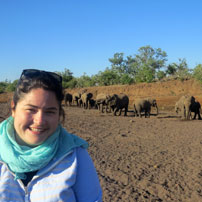 a beautiful orb spider and show us that as much as they would like to bite us, the size of their pincers just don’t allow it.
a beautiful orb spider and show us that as much as they would like to bite us, the size of their pincers just don’t allow it.
The Makuleke concession where the Pafuri Walking Trails are located is an absolutely stunning wilderness area. The variety of landscapes that you come across in a small amount of time is amazing. From lush floodplains and a beautiful fever tree forest to savannah scrubland and rocky gorges, it constantly changes. As well as the walking trails, we spent a night at Return Africa’s Pafuri tented camp and the luxurious Outpost lodge. Being sandwiched between the Limpopo river floodplain and the Luvuvhu river floodplain means that the ecosystem is rich and diverse. The area covers just 1% of the vast Kruger National Park but contains 75% of the biodiversity. One of the things that really stood out for us was the birdlife. It was astonishing and for anyone remotely keen on birds, this area is a haven. It is not known for big game, the hyaena are the apex preda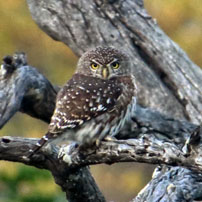 tor in the concession. Leopard are occasionally seen, and lion, but not often, so if you’re looking to tick off the big game, it’s not the right place for you, but if you want to see a completely different side to the Kruger and explore a stunning and diverse habitat, best enjoyed by foot, Pafuri really is an amazing place to spend a few days.
tor in the concession. Leopard are occasionally seen, and lion, but not often, so if you’re looking to tick off the big game, it’s not the right place for you, but if you want to see a completely different side to the Kruger and explore a stunning and diverse habitat, best enjoyed by foot, Pafuri really is an amazing place to spend a few days.
Just a few hours drive westwards from Pafuri, is the Tuli block in Botswana. This vast wilderness area sandwiched between Zimbabwe and South Africa offers some incredible game viewing. We spent two nights at Mashatu game reserve. My Dad was very keen to see a leopard and we got lucky with two sightings. Our first drive s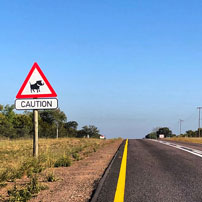 howed us a beautiful male leopard dangling in a tree. The second afternoon I went off to the Matebole photographic hide while Dad went on a game drive and got his second sighting of leopard, this time stalking a big herd of impala along the dry riverbed. As much as I would have enjoyed the leopard sighting, my afternoon in the hide really was fantastic. I have a bridge camera and sheepishly very much stick to the ‘auto’ setting the majority of the time. It was so useful to have a professional to guide me on what I should be doing to get the best of my camera and I picked up some useful tips. I was sitting next to a very keen photographer with a couple of big lenses, with his wife who didn’t even have a camera and was there just to enjoy the sightings. The photographic guide said they even get people who come in just with an iPhone sometimes, so it is not exclusively just for those with a keen eye for photography.
howed us a beautiful male leopard dangling in a tree. The second afternoon I went off to the Matebole photographic hide while Dad went on a game drive and got his second sighting of leopard, this time stalking a big herd of impala along the dry riverbed. As much as I would have enjoyed the leopard sighting, my afternoon in the hide really was fantastic. I have a bridge camera and sheepishly very much stick to the ‘auto’ setting the majority of the time. It was so useful to have a professional to guide me on what I should be doing to get the best of my camera and I picked up some useful tips. I was sitting next to a very keen photographer with a couple of big lenses, with his wife who didn’t even have a camera and was there just to enjoy the sightings. The photographic guide said they even get people who come in just with an iPhone sometimes, so it is not exclusively just for those with a keen eye for photography.
It’s an amazing opportunity being able to sit silently and wait while an almost painfully cautious kudu creeps up to the waterhole, or watch a little tree squirrel stretch and take a sip of water. We had to sit deathly still and wait until the guide indicated that we were able to start taking photos. Even the faint clicks of the cameras were enough to make the wildlife jump at first.As well as the big game areas of the Tuli Block and Makuleke, we s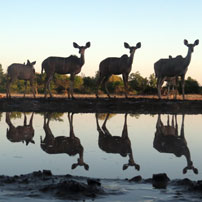 pent the first half of our trip experiencing the softer side of a South African safari, exploring the ‘malaria free’ Waterberg region. Within an easy drive of Johannesburg, there are several properties that serve as a fantastic ‘introduction’ to a safari, extremely well suited to families with little children and active teenagers a like. Jembisa Bush House offers a wonderfully warm home away from home feel, with a cosy lounge to curl up in at the end of the day, friendly dogs to greet you when you get back from your game drive and complete flexibility on activities. There is no dangerous game on the reserve which means children have a bit more freedom on activities, and you can do things like mountain biking, walking, sleeping out under the
pent the first half of our trip experiencing the softer side of a South African safari, exploring the ‘malaria free’ Waterberg region. Within an easy drive of Johannesburg, there are several properties that serve as a fantastic ‘introduction’ to a safari, extremely well suited to families with little children and active teenagers a like. Jembisa Bush House offers a wonderfully warm home away from home feel, with a cosy lounge to curl up in at the end of the day, friendly dogs to greet you when you get back from your game drive and complete flexibility on activities. There is no dangerous game on the reserve which means children have a bit more freedom on activities, and you can do things like mountain biking, walking, sleeping out under the 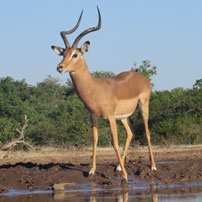 stars one night, and having a go at fishing in the river. On game drives, you’ll see plains game like giraffe and zebra and impala, but you need to go elsewhere to see your ‘Big Five’, either as a daytrip to a nearby reserve from Jembisa or you can easily combine a stay at Jembisa with Madikwe Game Reserve. Ants is another amazing place for families and couples a like, with a big highlight being horse riding. With over 50 horses, they cater for all abilities, from the complete beginner to people who want to ride all day every day.
stars one night, and having a go at fishing in the river. On game drives, you’ll see plains game like giraffe and zebra and impala, but you need to go elsewhere to see your ‘Big Five’, either as a daytrip to a nearby reserve from Jembisa or you can easily combine a stay at Jembisa with Madikwe Game Reserve. Ants is another amazing place for families and couples a like, with a big highlight being horse riding. With over 50 horses, they cater for all abilities, from the complete beginner to people who want to ride all day every day.
On our drive up from the Waterberg to the Tuli Block, we also spent a night at a little property called H12 Leshiba, nestled high up in the Soutpansberg Mountains. I had read that you feel like you are entering another world when you arrive at this property and that description is very apt. We crawled up the steep mountain road for 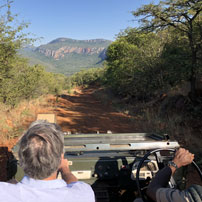 about half an hour, watching eagles soar above us around the mountains, and watched the scenery get more and more beautiful the higher we got. We got to a point where we started driving through the bush and the mountains disappear. Eventually you turn a corner and the scenery is truly breath-taking and other worldly. We enjoyed a sunset drive, again crawling our way round the mountain roads, the views changing every corner we took. There is some plains game on the property, as well as a friendly house cat called Christmas, but the scenery and remoteness is what makes H12 Leshiba special. You can set out on many a self-guided walking trail and explore the reserve or enjoy a guided walk and learn about the interesting biodiversity of the area and the vibrant birdlife.
about half an hour, watching eagles soar above us around the mountains, and watched the scenery get more and more beautiful the higher we got. We got to a point where we started driving through the bush and the mountains disappear. Eventually you turn a corner and the scenery is truly breath-taking and other worldly. We enjoyed a sunset drive, again crawling our way round the mountain roads, the views changing every corner we took. There is some plains game on the property, as well as a friendly house cat called Christmas, but the scenery and remoteness is what makes H12 Leshiba special. You can set out on many a self-guided walking trail and explore the reserve or enjoy a guided walk and learn about the interesting biodiversity of the area and the vibrant birdlife.
Self-driving around this area of South Africa and Botswana was a fantastic experience. The roads are wide open, empty and a pleasure to drive on, with the occasional pothole or rocky road to keep us on our toes. The range of landscapes we saw and experiences we had over our nine night trip was fantastic. I’ll remember the views from Leshiba, the hissing ants at Pafuri, the warmth and heart of the Jembisa, the elephants and leopards of Mashatu, and the silly excitement of my Dad every time something else amazing 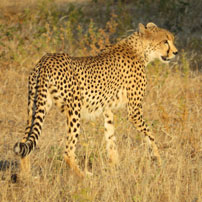 happened, for a long time to come.
happened, for a long time to come.
Frances stayed at Jembisa Bush Home, Ants Hill, H12 Leshiba, Mashatu Lodge, Pafuri Camp, Pafuri Walking Trail, The Outpost Lodge and Kings Walden Garden Manor.
Frances site inspected Leeuwenhof Country Lodge, Leobo Private Game Reserve, Marataba Safari Lodge, Mashatu Tent Camp and Coach House Hotel.
